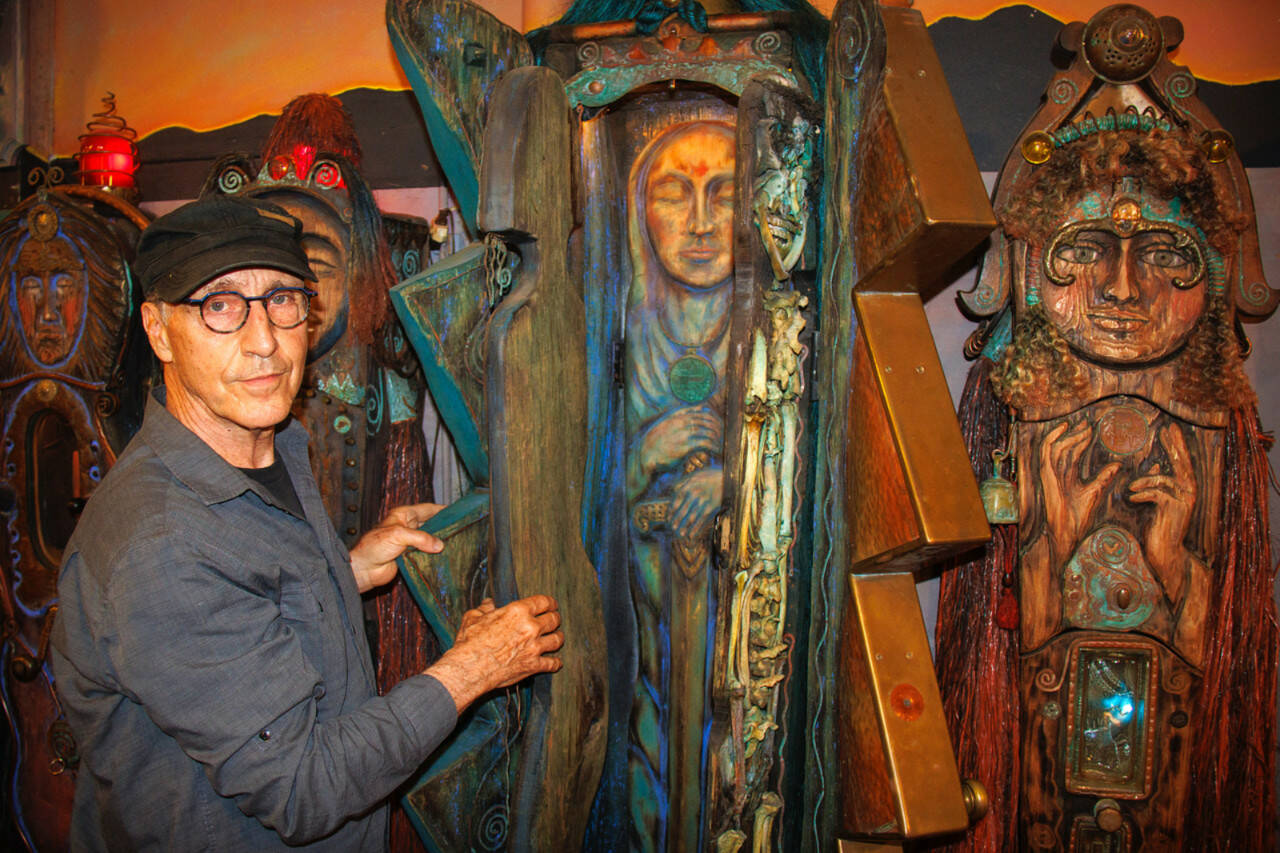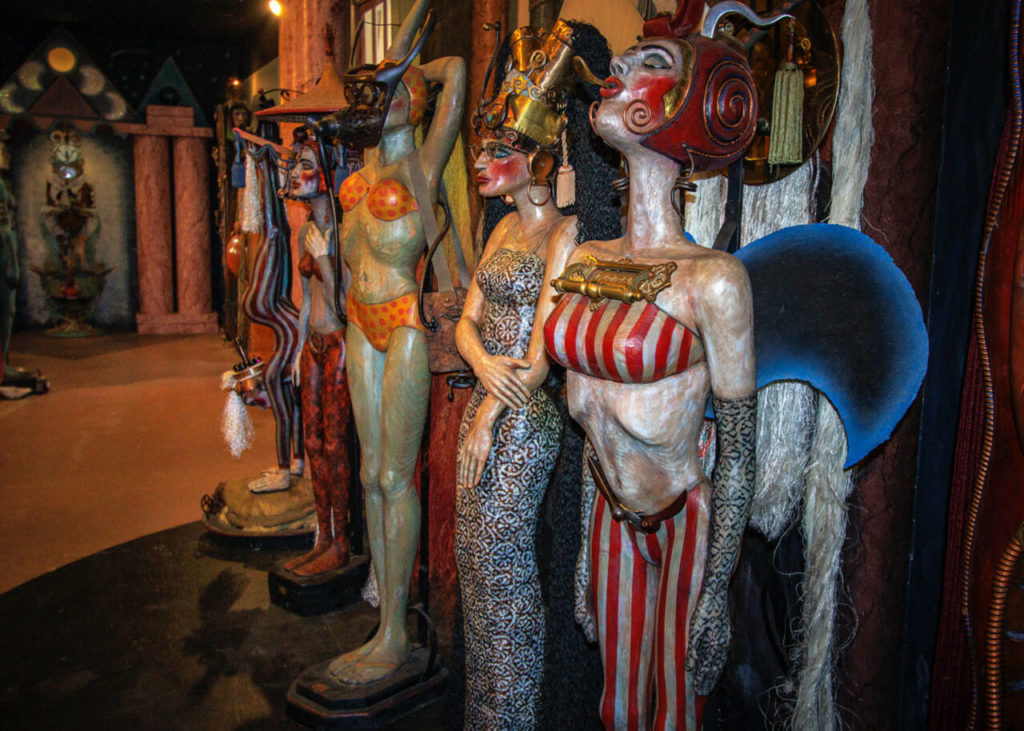WHIDBEY ISLAND — Tucked away in the dense, dark woods of south Whidbey Island lies one of the island’s best-kept secrets.
The lower level of Jerry Wennstrom’s home holds something fascinating: several tall, wooden sculptures resembling women that are meant to represent complex themes of birth and death, good and evil, femininity and masculinity. Each one is interactive in a unique way, and some are multilayered.
Wennstrom is the soft-spoken curator of this place that’s part museum, part arcade. He walks around the 2,000-square-foot space, flipping switches and turning cranks. His sarcophagus-like sculptures hum to life in various ways — a halo morphs into devil horns, a waving Buddha appears, false teeth chatter, a zoetrope sputters within a retro TV, Tibetan chanting ensues.
It’s safe to say that a tour through Wennstrom’s gallery is unlikely to compare to any other artist’s collection you’ve viewed before.
Wennstrom’s series of wooden sculptures is his second artistic body of work, which is detailed in his new book, “A Second Wind: Art Resurrected,” that came out earlier this year.
As a youngster, Wennstrom was known around the house as “The Doodler” for getting into trouble with the various art projects he created while unsupervised. This quiet style of art granted him some degree of celebrity later in life, when as a night janitor during his college years he became known as a phantom chalkboard artist for his doodles on a classroom blackboard.
The superficiality of the 1970s New York City art scene prompted him to destroy his first body of work, which were all paintings. One day, he removed the works from their frames and sent them on their way to the landfill, shortly before a documentary filmmaking crew showed up on his doorstep with the intent of capturing his art.
“You know, there’s a lot of magic in life,” Wennstrom said. “That’s what I had to find, separate from just making things.”
In the 15 years that followed, Wennstrom rid himself of belongings and lived a nomadic existence, fasting and contemplating his life thus far. Eventually, he traveled west to Whidbey Island to visit a friend.
“I moved here from New York with a backpack,” he said. “That was all I had, because I gave everything I owned away.”
On the south end of the island, he found a home in the welcoming arts community and Marilyn Strong, who would become his muse and wife. In the home they shared, he began painting again, this time in the form of murals on the walls of a workshop space located in the lower level of their dwelling.
Around the same time, he also started carving cabinets and sculptures using cedar from fallen or cut standing trees in the nearby forest, in addition to the occasional log or two from beaches. He embellished them with “hair” made from rope, pounded metals and found objects, much of which he perused Island Recycling for.
Most of his studio is now populated with art, but that was not always the case. In the beginning, he drew inspiration from an all-female spiritual wellness gathering led by Strong, which also occupied the space. Behind a sheer curtain, Wennstrom kept the beat on a drum as several women danced wildly in the room. The image of their moving figures seared into his memory, he set out to carve sculptures resembling that night.
“Women are more interesting,” he said, adding that “the feminine” is now being highlighted more often.
“You see it in politics, you see it in the movements in the world right now,” he said. “I think the masculine has run its course, with Trump being the most extreme, exaggerated bad example of the masculine gone awry.”
Wennstrom does not shy away from the subject of death, and other darker themes, in his art. In fact, he and Strong have already designed their own joint tombstone at the Langley Woodmen Cemetery. Strong has also been a death midwife for several years, helping people to pass away peacefully.
Over the years, friends have sent the couple a number of eerie items that have made their way into Wennstrom’s art, such as mummified barn cats and at least one human skull, purportedly won in an auction.
“A lot of people send in kind of spooky things,” Strong said.
Many of Wennstrom’s sculptures are influenced by real-life events, such as the passing of his younger brother. “Nurse Log,” a Christ-like figure, is so named for the hollow, rotting log the sculpture is placed within. In nature, a nurse log is a decaying tree that allows new life to sprout. The bottom half of the sculpture is skeletal, but the upper part is flesh. The bisected face, when folded open, reveals a second face below it.
Often he installs old motors into his sculptures, which animate the moving, interactive parts of his work. One of his friends referred to his style as “steampunk.”
“My grandfather, great-grandfathers were all machinists and inventors,” Wennstrom said. “So I think it’s just kind of in the blood.”
He gets a mischievous glint in his eye when he speaks about “The Alchemist,” a sculpture with a steam engine that caught on fire when the gas tank exploded. Fortunately, he didn’t burn the studio down and the most damage caused was to the “hair” of the sculpture, which ignited quickly.
“I hesitated to use the fire extinguisher,” he said. “I knew it was going to make a big mess.”
His most recent sculptures, rather than being encased in cabinets, are fully recognizable figures of tall, slim women in various active states, whether it’s clutching a cell phone, doing a handstand or putting on a gas mask. “The Intuitive,” a glasses-wearing sculpture, is featured on the cover of his new book. It was still in the process of being completed in 2020 when a photographer stopped by to take pictures for “A Second Wind.”
Deborah Koff-Chapin, a fellow South Whidbey artist and longtime friend of Wennstrom’s, has watched his art evolve over the years.
“I think they’re mature work,” she said of his second body of work. “I think he’s really developed a potent visual language of the psyche in his sculptures. I think they’re powerful, they’re beautiful, they have a lot of depth.”
Koff-Chapin, who paints by touch, was also searching for a way out of the New York art scene around the same time as Wennstrom.
“Art didn’t have much of a sacred context there,” she said. “People buy it because it’s an investment, it’s something people write about.”
For a time, she shared an art studio with Wennstrom in New York where he painted. Along the way, his paintings garnered interest from some famous persons, including the cultural anthropologist Margaret Mead.
“She had this wonderful sense of just being present and simple that just really left an impact on me,” Koff-Chapin recalled.
All 33 of Wennstrom’s works created within the last 25 years live inside the gallery of his home. He’s done a few exhibits here and there, but for the most part, his art stays nearby.
“He doesn’t sell art. He’s not a typical artist in that way,” Strong said. “That’s why we have a house full of it.”
As the couple have aged, they’ve started to wonder what will become of Wennstrom’s collection.
“We’re definitely in the conversation now as we get older,” Strong said. “We don’t have children and we have to figure out what to do with this property.”
One possible solution might involve creating a foundation organization to preserve the pieces in perpetuity.
Anyone is welcome to come view the gallery, which also doubles as a retreat space for spiritual wellness gatherings led by Strong.
Visitors’ reactions have ranged from awed to unsettled, the latter usually being in the case of small children. At least one pregnant woman was disturbed by part of a mural depicting a dark underworld. Worried that it would affect her pregnancy, she asked Wennstrom to cover it up. He gamely obliged.
“People are impressed, even if they don’t understand it,” he said.
Tim Leonard, owner of the Machine Shop, a Langley arcade, said he has been inspired by Wennstrom’s innovative, esoteric method of expressing himself.
“The creative way he executed his expression using found objects and objects that he carved and created and his clever use of old rope to make the hair of his pieces — they always had something unique about them in the fact that they did something that would force you to look at things differently,” Leonard said of Wennstrom’s sculptures.
Being mechanically gifted, the two men have shared an appreciation for machines over the years. Wennstrom even fixed up an old prophylactic machine for Leonard, which now dispenses runes instead of rubbers.
Other local island residents, such as Pam Schell, have commissioned Wennstrom to create art installations. In downtown Langley, an installation called “Chasing Carrots” involves a metal fabricated rabbit that will chase a carrot once a wheel is turned. Additionally, Wennstrom designed a dog-washing station for her business, the Inn at Langley.
“His workmanship is beautiful. There’s meaning in everything he does,” Schell said. “He’s that kind of man, just totally thoughtful and generous and quiet and intentional.”
As for what he’ll do next, Wennstrom has no idea. At his age, he said, putting together the new book encapsulating his work from the past 25 years was his “magnum opus.”
To learn more about Wennstrom’s art, visit handsofalchemy.com.
This story originally appeared in the Whidbey News-Times, a sister publication to The Herald.
Talk to us
> Give us your news tips.
> Send us a letter to the editor.
> More Herald contact information.


























